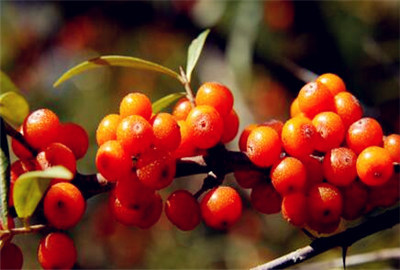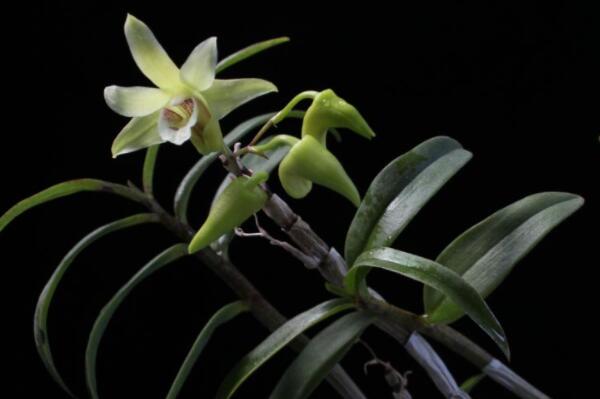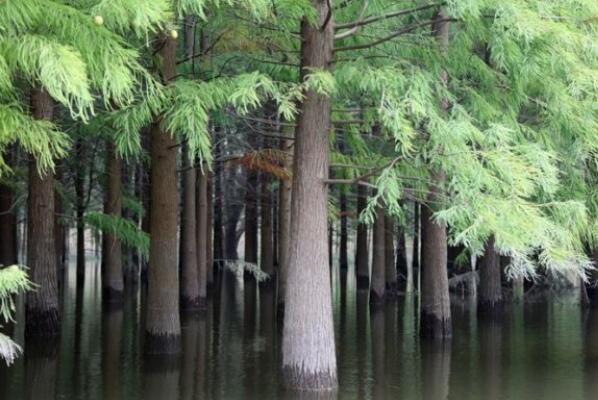2018 How much is a pound of sea buckthorn fruit? How many years to plant fruit? What's the yield per acre?
Hippophae rhamnoides fruit is the fruit of Hippophae rhamnoides of Elaeagnaceae, also known as vinegar willow fruit, sour fruit. Hippophae rhamnoides is a small berry plant, deciduous shrub or small tree. So how much is the seabuckthorn fruit per jin? How many years does seabuckthorn grow to hang fruit? What is the yield per mu?

The growth of Hippophae rhamnoides is slow in 1 ~ 2 years, faster in 4 ~ 6 years, and slower after that. Seabuckthorn plants blossom and bear fruit for 3 ~ 5 years, but the amount of fruit is small; 10-15 years is the full fruit period, and it begins to decline after 30 years. After an interval of about 3 years, the branches will renew and the trees will flourish, and a new peak period of fruit can be ushered in. The fruit yield per plant of Hippophae rhamnoides varies greatly with different regional conditions, and the fruit yield per plant is 21.5 kg during the full fruit period. The fine varieties selected by manual breeding can reach more than 20 kg. Qinghe is located in the cold temperate zone north of 45 degrees north latitude, which is the most suitable area for planting Hippophae rhamnoides, with a maximum yield of 800kg to 1000 kg per mu.
Planting density of Hippophae rhamnoides: in the Hippophae rhamnoides orchard with large crown, the row spacing can be 2 m × 4 m with 83 plants per mu, and the spike nursery with 1 m × 3 m can be planted with 220 plants per mu. The size of the tree hole depends on the size of the sapling, usually 35 cm in diameter and 35 cm deep. It is better for two-year-old softwood cuttings.
How many years does seabuckthorn grow to hang fruit? What is the yield per mu?
The right time for harvest. The ripening period of Hippophae rhamnoides fruit is marked by its unique color and fruit size, and the harvest time is determined accordingly. Under normal circumstances, varieties introduced from high latitudes such as Russia and Inner Mongolia mature earlier, such as Chuysk and Altai, can mature in early August, superior varieties such as Hippophae rhamnoides and orange seabuckthorn, mostly mature in late August. Chinese home-grown Central Asian seabuckthorn matured in late August. Chinese seabuckthorn comes from different populations, and its heat formation period is also different. the fruit ripening period of Hippophae rhamnoides in North China, such as Zhuolu and Fengning, is from late August to early September, while that in Northwest China, such as Gansu and Qinghai, is mostly mature in mid-late September.
What is the price of Hippophae rhamnoides on the market?
According to Mr. Wang, a grower of Hippophae rhamnoides, the fruit of Hippophae rhamnoides on the market is 28.5 yuan per jin.
How many trees can be planted on one mu of land?
The seedlings of Hippophae rhamnoides are relatively small, with a general plant height of 30-50 cm and a ground diameter of 5-8 mm. The labor intensity of planting Hippophae rhamnoides is not great. An ordinary labor force can plant 5-6 mu of seabuckthorn a day, and 220 seabuckthorn can be planted on one mu of land.
How many jin of fruit per mu of seabuckthorn?
If it is based on planting 220 seabuckthorns per mu, the yield of seabuckthorn fruit per mu is about 600-800 kg.
What are the planting techniques of Hippophae rhamnoides?
1. Seed propagation
Soak the seeds before spring sowing, row spacing 10-15cm strip sowing, depth 3cm. One week later, the seedlings emerged, when the first pair of true leaves appeared, the seedlings began to grow, and when the fourth pair of true leaves appeared, the distance between plants kept 5cm. Autumn sowing should be carried out in late autumn, covering the border after sowing, watering and freezing in winter, and emergence of seedlings in the following year.
2. Cuttage propagation
The medium mature growing branches were selected for cuttings, the cutting period was not from mid-June to August, and the row spacing was (10-15) cm × (5-10) cm. In the second spring, the row spacing was (30-60) cm × (15-17) cm. Afforestation with asexual propagation seedlings for 1-2 years, the planting density is the best, and the row spacing is 4m × 2m. For different types or varieties of fruit ripening period, it can be planted in pieces to facilitate management. When planting, pay attention to the reasonable ratio of male and female, generally 8 female plants with 1 male plant.
3. Field management
In order to improve soil fertility, attention should be paid to weeding by ploughing. Hippophae rhamnoides is sensitive to phosphate fertilizer and calcium superphosphate can be applied as appropriate to facilitate plant growth.
4. Growth management
The growth of Hippophae rhamnoides can be divided into four stages: seedling stage, fruit stage, fruit stage and decline stage. Within two years after planting, it mainly grew underground, while the aboveground part grew slowly. It grew vigorously for 3-4 years and began to blossom and bear fruit. The height of adult Hippophae rhamnoides is 2-2.5 meters and the crown width is 1.5-2 meters. The fifth year entered the prosperous fruit period. Due to the different soil conditions and management, the time of entering the decline period is also different, and the general tree age enters the decline period after 15 years of age.
twelve
Time: 2019-03-21 Click:
- Prev

What kind of fertilizer does Dendrobium candidum of Orchidaceae use? What if the leaves turn yellow? How much is the price of seeds and seedlings?
Dendrobium candidum, also known as Black Section Grass, Yunnan Iron, Iron Dou, florescence from March to June. Born on semi-shady rocks in mountains up to 1600 meters above sea level. So what kind of fertilizer should it use? What if the leaves turn yellow? How much is the price of seeds and seedlings
- Next

When will Metasequoia glyptostroboides, a rare tree, lose its leaves? What is the medicinal value? How to keep and trim bonsai?
Metasequoia glyptostroboides, alias Alsophila, tall deciduous trees, up to 35 meters high. The tree is graceful and is a famous garden tree species. So when will it lose its leaves? What is the medicinal value? How to keep and trim bonsai? According to the data of Taxodiaceae, the leaves of Metasequoia glyptostroboides are arranged in two rows on the lateral branchlets, pinnate, and fall off with the branches in winter.
Related
- Fuxing push coffee new agricultural production and marketing class: lack of small-scale processing plants
- Jujube rice field leisure farm deep ploughing Yilan for five years to create a space for organic food and play
- Nongyu Farm-A trial of organic papaya for brave women with advanced technology
- Four points for attention in the prevention and control of diseases and insect pests of edible fungi
- How to add nutrient solution to Edible Fungi
- Is there any good way to control edible fungus mites?
- Open Inoculation Technology of Edible Fungi
- Is there any clever way to use fertilizer for edible fungus in winter?
- What agents are used to kill the pathogens of edible fungi in the mushroom shed?
- Rapid drying of Edible Fungi

